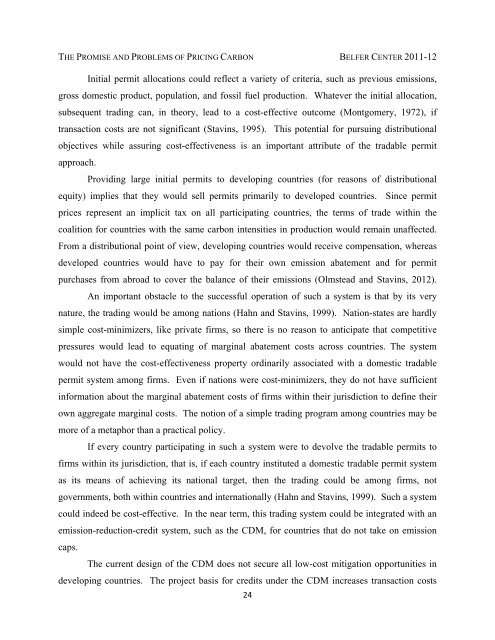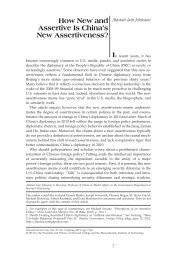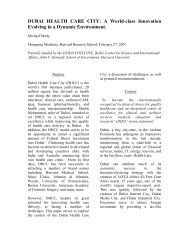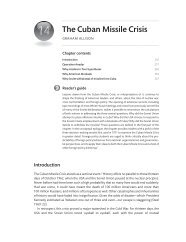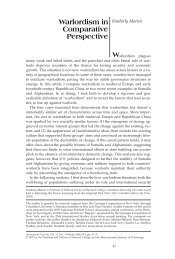The Promise and Problems of Pricing Carbon: - Belfer Center for ...
The Promise and Problems of Pricing Carbon: - Belfer Center for ...
The Promise and Problems of Pricing Carbon: - Belfer Center for ...
You also want an ePaper? Increase the reach of your titles
YUMPU automatically turns print PDFs into web optimized ePapers that Google loves.
THE PROMISE AND PROBLEMS OF PRICING CARBON BELFER CENTER 2011-12<br />
Initial permit allocations could reflect a variety <strong>of</strong> criteria, such as previous emissions,<br />
gross domestic product, population, <strong>and</strong> fossil fuel production. Whatever the initial allocation,<br />
subsequent trading can, in theory, lead to a cost-effective outcome (Montgomery, 1972), if<br />
transaction costs are not significant (Stavins, 1995). This potential <strong>for</strong> pursuing distributional<br />
objectives while assuring cost-effectiveness is an important attribute <strong>of</strong> the tradable permit<br />
approach.<br />
Providing large initial permits to developing countries (<strong>for</strong> reasons <strong>of</strong> distributional<br />
equity) implies that they would sell permits primarily to developed countries. Since permit<br />
prices represent an implicit tax on all participating countries, the terms <strong>of</strong> trade within the<br />
coalition <strong>for</strong> countries with the same carbon intensities in production would remain unaffected.<br />
From a distributional point <strong>of</strong> view, developing countries would receive compensation, whereas<br />
developed countries would have to pay <strong>for</strong> their own emission abatement <strong>and</strong> <strong>for</strong> permit<br />
purchases from abroad to cover the balance <strong>of</strong> their emissions (Olmstead <strong>and</strong> Stavins, 2012).<br />
An important obstacle to the successful operation <strong>of</strong> such a system is that by its very<br />
nature, the trading would be among nations (Hahn <strong>and</strong> Stavins, 1999). Nation-states are hardly<br />
simple cost-minimizers, like private firms, so there is no reason to anticipate that competitive<br />
pressures would lead to equating <strong>of</strong> marginal abatement costs across countries. <strong>The</strong> system<br />
would not have the cost-effectiveness property ordinarily associated with a domestic tradable<br />
permit system among firms. Even if nations were cost-minimizers, they do not have sufficient<br />
in<strong>for</strong>mation about the marginal abatement costs <strong>of</strong> firms within their jurisdiction to define their<br />
own aggregate marginal costs. <strong>The</strong> notion <strong>of</strong> a simple trading program among countries may be<br />
more <strong>of</strong> a metaphor than a practical policy.<br />
If every country participating in such a system were to devolve the tradable permits to<br />
firms within its jurisdiction, that is, if each country instituted a domestic tradable permit system<br />
as its means <strong>of</strong> achieving its national target, then the trading could be among firms, not<br />
governments, both within countries <strong>and</strong> internationally (Hahn <strong>and</strong> Stavins, 1999). Such a system<br />
could indeed be cost-effective. In the near term, this trading system could be integrated with an<br />
emission-reduction-credit system, such as the CDM, <strong>for</strong> countries that do not take on emission<br />
caps.<br />
<strong>The</strong> current design <strong>of</strong> the CDM does not secure all low-cost mitigation opportunities in<br />
developing countries. <strong>The</strong> project basis <strong>for</strong> credits under the CDM increases transaction costs<br />
24


